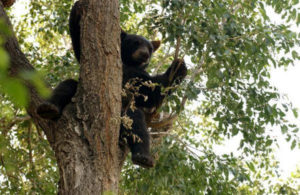San Luis Obispo, Calif. – Late yesterday, in a victory for our region’s wildlife, the Department of Fish & Game formally withdrew its proposal to allow the first-ever black bear hunting season in San Luis Obispo County. In making the announcement, Department officials cited the need to gather additional data for several years so that the agency could adequately respond to public concerns.
This was the third time in two years that the Department cancelled plans to open San Luis Obispo County to bear hunting. The Department initially released its proposal in February 2009, allowing up to fifty bears per year to be killed in San Luis Obispo County, primarily in the Los Padres National Forest. The Department withdrew that proposal in April 2009, only to reissue it again in February 2010, along with additional proposals to remove the numerical limit on the number of bears that could be killed each year statewide and allowing hunters to use high-tech GPS devices to track bears.

That proposal was withdrawn in March 2010, and yesterday’s announcement cancelled any plans the Department had to allow bear hunting in San Luis Obispo County in 2011 and beyond. At yesterday’s hearing, the Department also withdrew plans to allow GPS devices.
“We’re pleased that Fish & Game finally understands the necessity of accurate population studies,” said Jeff Kuyper, executive director of Los Padres ForestWatch, a nonprofit conservation organization that spearheaded efforts to defeat the San Luis Obispo County hunting proposal. “From the beginning, the Department’s proposals were plagued by missing data and mathematical errors. Our County’s bears deserve better.”
Responding to ForestWatch complaints that last year’s proposal was not based on an accurate population study, this year’s proposal provided an estimate that 1,067 black bears occur in San Luis Obispo County. In calculating that number, Department officials assumed that 4,918 square miles of bear habitat exists in the County, even though – according to the U.S. Census Bureau – San Luis Obispo County spans only 3,304 square miles of land, not 4,918. By overestimating the amount of bear habitat by more than 150%, the State had grossly inflated the number of bears in the County.
The announcement was made during the Fish & Game Commission’s hearing yesterday in McClellan, California. During that hearing, Dr. Eric Loft, the Chief of the Department’s Wildlife Branch, stated: “We do not plan to come back with additional hunt proposals in the Central Coast Range in 2011. Instead, over the next few years, we’re going to plan to further assess that relatively new and growing population that’s in the Central Coast.”
Dr. Loft later referred to public comments on the Department’s environmental analysis as the primary reason for gathering additional data. “Because of the comments that we received on our environmental document, we actually believe it would be fruitful for us to go back and gather some additional data on the bear population in that part of the state,” said Dr. Loft.
Earlier this year, the San Luis Obispo County Board of Supervisors approved a resolution opposing the black bear hunting proposal. The Board’s opposition was based, in large part, on Fish & Game’s continued refusal to hold a local hearing. In addition, the Department received more than 10,000 public comments opposing the bear hunting expansion proposal. These comments – particulary those submitted by Dr. Rick Hopkins, one of the most experienced wildlife biologists in the state, coupled with a letter authored by wildlife attorney Bill Yeates of the Kenyon Yeates law firm in Sacramento – were cited by Fish & Game officials when the 2010 plan was temporarily tabled in March.
“Having accurate bear population data is critical – without it, the Department has no scientific basis to determine if, and at what levels, hunting should occur,” said Kuyper. Fish & Game decided against using more accurate population indicators that are used by wildlife management agencies in other states. For example, DNA analysis of hair or scat can distinguish one bear from another, providing precisely the data needed for a reliable population estimate. Oklahoma recently completed a DNA study of its bears.
ForestWatch estimates that it will take several years for the Department to gather data needed for an accurate population study. “Until then, our region’s black bears will continue to have the freedom to roam in the Los Padres National Forest.”







Comments are closed.